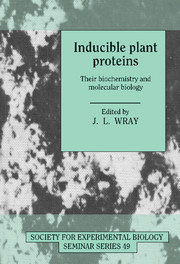Book contents
- Frontmatter
- Contents
- List of Contributors
- Preface
- Metal-binding proteins and metal-regulated gene expression in higher plants
- Phosphate starvation inducible enzymes and proteins in higher plants
- Nitrate reduction in higher plants: molecular approaches to function and regulation
- Inducibility of the glutamine synthetase gene family in Phaseolus vulgaris L.
- Expression and manipulation of genes involved in phenylpropanoid biosynthesis
- Biochemistry and molecular biology of CAM
- ABA- and GA-responsive gene expression
- Regulation of gene expression, ethylene synthesis and ripening in transgenic tomatoes
- Induction of nodulin genes and root nodule symbiosis
- Systemic acquired resistance: an inducible defence mechanism in plants
- Biochemistry and molecular biology of the anaerobic response
- The heat shock response in transgenic plants: the use of chimaeric heat shock genes
- Biochemistry and molecular biology of cold-inducible enzymes and proteins in higher plants
- GBF-1, GBF-2 and GBF-3: three Arabidopsis b-Zip proteins that interact with the light-regulated rbcS-1A promoter
- Index
Biochemistry and molecular biology of cold-inducible enzymes and proteins in higher plants
Published online by Cambridge University Press: 06 July 2010
- Frontmatter
- Contents
- List of Contributors
- Preface
- Metal-binding proteins and metal-regulated gene expression in higher plants
- Phosphate starvation inducible enzymes and proteins in higher plants
- Nitrate reduction in higher plants: molecular approaches to function and regulation
- Inducibility of the glutamine synthetase gene family in Phaseolus vulgaris L.
- Expression and manipulation of genes involved in phenylpropanoid biosynthesis
- Biochemistry and molecular biology of CAM
- ABA- and GA-responsive gene expression
- Regulation of gene expression, ethylene synthesis and ripening in transgenic tomatoes
- Induction of nodulin genes and root nodule symbiosis
- Systemic acquired resistance: an inducible defence mechanism in plants
- Biochemistry and molecular biology of the anaerobic response
- The heat shock response in transgenic plants: the use of chimaeric heat shock genes
- Biochemistry and molecular biology of cold-inducible enzymes and proteins in higher plants
- GBF-1, GBF-2 and GBF-3: three Arabidopsis b-Zip proteins that interact with the light-regulated rbcS-1A promoter
- Index
Summary
Introduction
Plants growing in temperate climates are often exposed to cold stress which can kill the plants. The cold or low temperature stress can be subdivided into chilling (temperatures above 0°C) and freezing (subzero temperatures) stress. The absolute temperatures which lead to damage in plants vary markedly between different plant species. Cold resistance measured as the frost killing point is not a constant for a genetically pure variety but is strongly influenced by environmental factors and the developmental stage of the plants.
Two basic mechanisms to survive a low temperature stress have evolved in plants: either to avoid the fatal temperature or to adapt to the low temperature by developing tolerance towards the stress. Although the plant is essentially unable to avoid the freezing temperature of its environment, it is suggested by Levitt that some protection can be obtained by supercooling or accumulation or antifreeze as a mechanism for avoidance (Levitt, 1980). On the other hand, many temperate plant species have the capability of cold acclimation: exposure to a period of low, non-freezing temperatures can lead to a significant increase of cold tolerance (Levitt, 1980). This process is termed cold acclimation or cold hardening. The interrelationship of these different processes is shown in Fig. 1.
The subject of this chapter will be to summarise the biochemical and molecular changes which take place during the process of cold acclimation and the acquisition of freezing stress tolerance.
- Type
- Chapter
- Information
- Inducible Plant ProteinsTheir Biochemistry and Molecular Biology, pp. 267 - 288Publisher: Cambridge University PressPrint publication year: 1992
- 10
- Cited by



